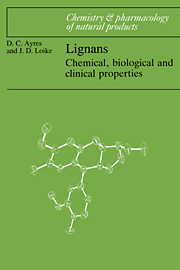Book contents
- Frontmatter
- Contents
- To students and colleagues in Westfield College, 1965–1984.
- Preface
- Glossary for lignans
- 1 Introduction
- 2 A registry of the natural lignans
- 3 Biological and clinical properties of podophyllotoxin and other lignans
- 4 Etoposide and Teniposide
- 5 Isolation, purification and initial characterisation
- 6 Determination of structure
- 7 Biosynthesis
- 8 Synthesis
- Botanical index
- General index
8 - Synthesis
Published online by Cambridge University Press: 05 February 2012
- Frontmatter
- Contents
- To students and colleagues in Westfield College, 1965–1984.
- Preface
- Glossary for lignans
- 1 Introduction
- 2 A registry of the natural lignans
- 3 Biological and clinical properties of podophyllotoxin and other lignans
- 4 Etoposide and Teniposide
- 5 Isolation, purification and initial characterisation
- 6 Determination of structure
- 7 Biosynthesis
- 8 Synthesis
- Botanical index
- General index
Summary
Useful information is contained in a collection of general articles (Rao et al., 1978) and the synthesis of lignans and neolignans has been reviewed in detail (Ward, 1982). In this review some attention has been paid to old-established methods but the writer has concentrated on developments post 1980.
Owing to the existence of large groups of reference compounds and to the power of modern spectroscopic methods, synthetic techniques are no longer essential to the proof of structure. However, the synthetic approach is vital for the preparation of lignans with useful physiological properties whenever the yields from natural sources are inadequate.
Oxidative coupling
Numerous examples of biomimetic synthesis exist which depend upon this procedure. These were illustrated in the previous chapter (cf. Schemes 7.7, 7.8, 7.9, 7.11) and others which relate to the various classes of lignans are given here.
This method is of interest because of the analogy with biosynthesis. However, as we have seen in oxidative lignin synthesis (p. 272), a number of pathways are usually open and low yields of specific lignans are commonly obtained. An early review (Harkin, 1967) discusses the simulated synthesis of lignin by the oxidative coupling of p-hydroxycinnamyl alcohols. Another contribution (Weinges and Spanig, 1967) in the same source describes the limited examples then available of this route to lignans.
In fundamental studies (Freudenberg, 1959, 1965) of lignin synthesis the free radical (8.1; X = H) derived from eugenol and the coupled quinone methide (8.2; X = H) were identified as intermediates but their half-lives are limited, being only 45 seconds and 1 hour respectively in 1:1 dioxan: water at 20°C.
- Type
- Chapter
- Information
- LignansChemical, Biological and Clinical Properties, pp. 303 - 384Publisher: Cambridge University PressPrint publication year: 1990



